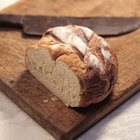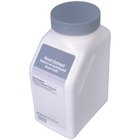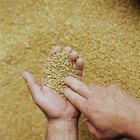
The use of a starter when baking bread shortens the rising time and gives the bread a complex, developed flavor not ordinarily available through the use of only yeast. Making your own sourdough -- or starter-based -- bread is not hard, but it is an act of commitment; the use of a bad starter is not only dangerous but could be deadly.
Bad Starters
Starters work by creating an ideal place for wild yeast and friendly bacteria to settle and populate. If treated correctly, these friendly microorganisms will make the dough untenable for unfriendly germs -- the friendly bacteria will produce lactic acid, which will make the bread tangy and the starter toxic to most microorganisms. However, if you allow the yeast in your starter to die, room will become available for germs and toxin-forming bacteria -- such as E. coli -- to settle in. While many bakers would argue that almost all starters can be saved -- considering that there may be a chance of serious contamination -- discard starters that show signs of distress to be safe.

Signs of Contamination
A starter should be white, light gray or light tan. It should smell like bread dough, of yeast or of its ingredients. It should bubble subtly and occasionally burp. If the starter has liquid on top of it -- this is called hooch, and it is the alcohol the starter’s yeast produces from fermentation -- it should be clear, white, light gray or light brown. If the starter or its hooch is pink, green or dark brown, discard the starter. If it smells or looks moldy, discard the starter. If the starter is fizzing or the starter has spots or patches -- which are signs of foreign bacterial growth -- discard the starter.

Taking Care of Your Starter
Think of your starter as a pet in the sense that you must tend to it lovingly every day. Your starter’s container should be clean, and -- at least once every week -- transfer the starter to a clean container. Mold that would eventually kill a starter usually grows on the starter’s container first. Your starter can live at room temperature if you intend to bake bread every day. You can store the starter in an open container covered by a kitchen towel. Room-temperature starters must be fed at least every day, per your starter’s recipe.
Less frequent bread baking requires you to keep your starter in the refrigerator, as the cold will slow fermentation. Refrigerated starters only need to be fed once a week or as needed to replenish the quantity. Whisk or fold the starter’s “food” -- the flour, water and additional yeast needed to replenish the starter -- into the starter. Doing so breaks up carbon dioxide buildup and introduces fresh oxygen to the yeast.

Bread as a Living Being
Your starter will grow and change as it develops. For example, if you start your starter with a sample from San Francisco to have real San Francisco sourdough at home, within three months -- unless you live in the Bay Area -- your starter will taste of the yeasts local to you. Yeast and bacteria will continue to colonize your starter, even if it is already populated. Ensure that your starter stays happy and healthy. It is not uncommon to hear of starters that are more than 100 years old; with enough care, your great-grandchildren may find themselves fighting over your starter.

Related Articles

How to Make a Bread Starter

How to Revive a Sourdough Starter Gone ...

How to Grow Bread Yeast

How to Ferment Grains

Does Light Affect How Long Bread Will ...

Can You Proof Yeast in Warm Milk?

Does Bread Expire?

How to Ferment Milk

How to Eradicate the Smell of a Dead ...

What Happens if the Yeast Dies Before ...

Does Yeast Cause Holes in Bread?

How to Make Hard Cider With Baking Yeast

Can You Substitute Yogurt for Milk in ...

When Does Dry Yeast Expire?

How to Clean a Musty Smell from the ...

List of Greek Breads
How to Keep Crusty Italian Bread Soft

How to Soften Overly Hard Bread

What Type of Microorganism Is Used to ...

How Long Do Shucked Oysters Stay Fresh?
References
Writer Bio
Frederick Reese is an author and political journalist who has covered current affairs, culture and society for various print and online publications. Reese holds a B.A. in art and art history from Colgate University.
Photo Credits
Steve Baccon/Digital Vision/Getty Images